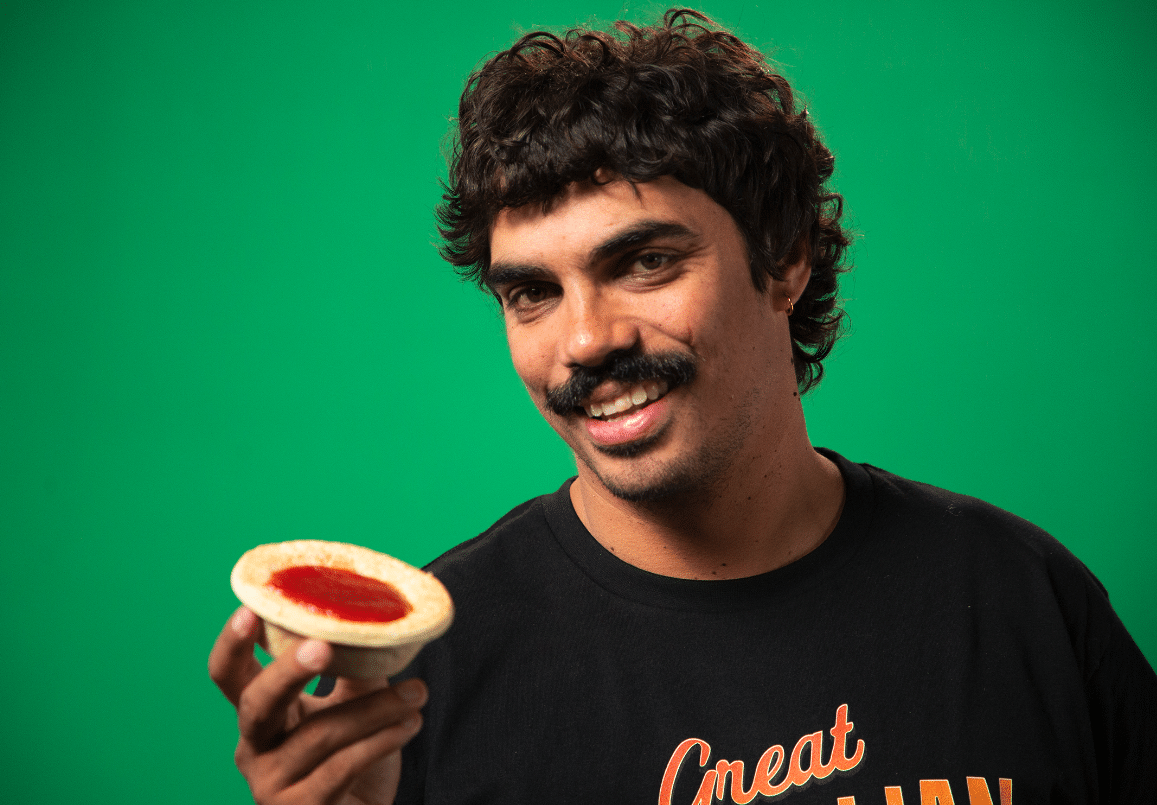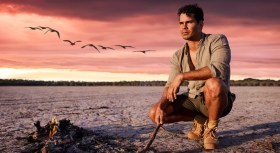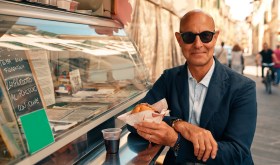Great Australian Stuff is a four-part popular history series that asks, in the most casual and soft-hitting way, what makes certain Australian stuff great. Produced for the ABC – and taking advantage of the public broadcaster’s deep, deep archive – by WildBear Entertainment, it’s hosted by the ever-charming Tony Armstrong, who also fronted a previous WildBear series, 2022’s A Dog’s World.
Episode one, ‘Food’, focuses on celebrated Aussie ingredients and products; episode two, ‘The Land’, investigates everything from boomerangs, sheep and kelpies to landscape-inspired fashions and fire management techniques.
Read: TV Review: A Dog’s World with Tony Armstrong
Episode three, ‘Home’, examines cars, goon, Hills Hoists and the delights of the Australian Women’s Weekly Children’s Birthday Cake Book. And in the final episode, ‘Play’, former AFL footballer Armstrong marks a Sherrin, introduces the Indigenous game of marn-grook, ponders Speedos and surf lifesaving, celebrates gambling, and marvels at Gay and Lesbian Mardi Gras costumes.
Meanwhile, various talking heads pop up onscreen to reminisce: TV personality Benjamin Law, comedians Nazeem Hussein and Jean Kittson, ABC hosts Richard Glover and Daniel Browning, and even New York Times Australian bureau chief Damien Cave, for that piquant dash of cultural cringe.
What is with the Australian urge to celebrate the same stuff, again and again? It makes Australian culture seem so impoverished. Great Australian Stuff also seems to be going over a lot of the same consumer-culture ground as the current ABC retail-history show Back in Time for the Corner Shop, and has borrowed much of its format from Channel Nine’s long-running clip show 20 to One.
So, can this series do anything fresh with such well-worn material?
Breaking with colonial consumer parochialism
The program is driven by a powerful combination of nostalgia and parochial pride. It asks the viewer to ponder their own personal history with each item it describes. But it also asks us to consider the nation-building role of consumer culture.
The format means that it feels a lot like a victory lap. Many of the items discussed here were chosen because there was copious archival footage of them – particularly from 1960s and 1970s ABC documentaries. This means the show won’t offer many surprises to anyone who’s been paying attention to the media for the past 50 years. Quite often, the vibe is, ‘Oh yeah, that‘.
I also wish it had ditched the filler ‘entertainers’ in favour of the other talking heads here, who include historians, museum curators, authors of books about Great Australian Stuff (which also goes to show how well-trodden this ground is) and other topic experts such as chefs and fashion designers. Their comments are informed by research and practice, not reminiscence.
Pre-colonisation
However, the series does strive to offer something beyond selectively recoloured black-and-white footage, talking heads joking about the sexual connotations of a Chiko Roll, or Tony Armstrong demolishing a pie and deftly juggling Granny Smith apples.
Commendably, Great Australian Stuff works hard to include pre-colonial Stuff. When discussing macadamia nuts, chef and author Nornie Bero – a Komet Meriam woman from the Torres Strait – also lists her personal top five local ingredients, while Professor Margo Neale, from the Centre for Indigenous Knowledges at the National Museum of Australia, talks about how much better suited these plants are to our climate and soils.
Read: The Pope’s Exorcist review: God only knows
For a minute I glimpsed an exciting future of greatness for Australian farming and food. But just as we learn Hawaii and South Africa were quicker than Australia to understand the commercial potential of macadamias, so many of these tales of ‘greatness’ are also ‘lucky country’ stories about the poor judgment calls of British colonisers.
For instance, we only got rabbit-felt Akubra hats because of the rabbit plagues caused by white settlers who introduced rabbits to hunt for sport, then exterminated the native predators that could have kept down rabbit numbers. And we’ve only started to take firestick farming practices seriously in recent years, after non-Aboriginal fire management orthodoxies woefully failed to prevent huge losses of land and lives in bushfires.
Do consumer goods really build a nation?
As the flippant term ‘stuff’ implies, Great Australian Stuff seeks to elevate ordinary things to an immortal plane, as national symbols of innovation and excellence – and even as harbingers of social and cultural change. But ‘stuff’ here often means ‘branded products’; and Great Australian Stuff sometimes risks celebrating the art of marketing. If you somehow didn’t know the central role that advertising played in popularising Vegemite, Gruen pundit Dee Madigan is here to remind you.
Consumer culture can exploit nationalistic impulses to the point where we believe the product builds the nation. Sometimes, Great Australian Stuff digs into how this capitalist sausage is made: it was intriguing to learn the central role commercial art played in branding Granny Smiths, via the brightly coloured posters on the sides of the wooden crates in which the apples were shipped.
And I was relieved the episode manages to discuss meat pies without quoting the 1970s jingle ‘Football, meat pies, kangaroos and Holden cars’ – which, in any case, is not especially Australian, having been directly adapted from ‘baseball, hot dogs, apple pies and Chevrolets’.
More fruitfully, the series asks why certain stuff has not endured. As readers of Andrew Pippos’s acclaimed novel Lucky’s will know, the Greek milk bar (which, for those reading in Victoria, was a café, not a corner shop) didn’t serve Greek food, but rather introduced US-style diner culture into Australia, ironically enabling its own demise at the hands of newer American fast-food chains.
And the aspirin–amphetamine compound Bex was socially toxic long before its carcinogenic links were identified: its use papered over structural misogyny.
Captains of capitalism
‘But sometimes capitalists were good!’ the show insists as it recounts the story of MacPherson Robertson, a Melbourne chocolate baron who happened to have principles that look progressive today, such as daily physical exercise, female workers’ rights and an interest in emerging technologies.
‘Mac.Robertson’, as he was known, funded Douglas Mawson’s Antarctic expeditions – and had a slice of Australia’s huge Antarctic territory named after him – invested in the airline that would become Ansett, and endowed Mac.Robertson Girls’ High School, one of Australia’s leading selective state schools. Does this link the Freddo Frog to climate-change research? No.
Read: The Super Mario Bros. Movie review: It’s-a mess!
We seem to be in a particularly uncritical cultural moment of celebrating consumer goods as entertainment. The new Ben Affleck film Air is, ironically, suffocatingly flat, simplistically celebrating Nike staffers as heroic ideas men, not venal sneaker pimps. Maybe Barbie will be better than The Super Mario Bros. Movie because the doll was always a vehicle for imaginative play. And at least Tetris had the good taste to pose as a Cold War spy thriller.
In this context, it’s worth remembering that consumer goods buy our affection so we’ll buy them. And while stuff can certainly reveal much about the forces that shape nations, nationalism can also be a destructive, stultifying force.
Rather than taking comfort in a nostalgic past ‘greatness’, we’ll move forward as a nation by seeking greatness in new places.
Great Australian Stuff airs from Tuesday 11 April at 8pm on ABC TV and ABC iview.





